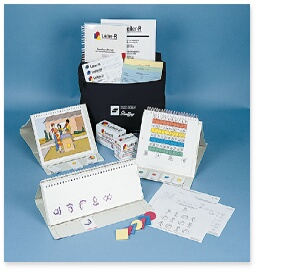| ||||

The fully revised Leiter-R is completely nonverbal. Neither the examiner nor the child is required to speak, and the child doesn’t need to read or write, either. The test’s engaging, game-like tasks hold the child’s interest, and its easy administration and quick, objective scoring make for an efficient assessment.
Because the Leiter-R is nonverbal, it is especially suitable for children and adolescents who are cognitively delayed, disadvantaged, nonverbal or non-English speaking, speech or hearing impaired, motor impaired, ADHD, autistic, or suffering from traumatic brain injury. It spans ages 2 years, 0 months through 20 years, 11 months.
The Leiter-R consists of two nationally standardized batteries:
Visualization and Reasoning Battery Attention and Memory Battery
REASONING: MEMORY:
Classification Memory Span (Forward)
Sequential Order Spatial Memory
Repeated Patterns Associative Memory
Design Analogies Immediate Recognition
Memory Span (Reverse)
VISUALIZATION: Visual Coding (Symbol and Digit)
Matching Associative Delayed Memory
Picture Context Delayed Recognition
Figure-Ground
Paper Folding ATTENTION:
Form Completion Attention-Sustained
Figure Rotation Attention-Divided
The Attention and Memory Battery distinguishes children with ADHD or other neuropsychological impairments from typical children. It also enhances interpretation of the global IQ score by providing valuable diagnostic indicators that help explain scores on the Visualization and Reasoning Battery. For example, the battery enables psychologists to determine whether low academic achievement in subjects such as mathematics, spelling, and reading is a result of a low IQ or specific neuropsychological causes such as ADHD.
Included in both batteries are unique “growth” scores, which measure small, but important, improvement in children with significant cognitive disabilities. This allows psychologists, educators, and parents to see improvement across time, regardless of age-based standard scores.
Unlike other IQ tests, the Leiter-R emphasizes fluid intelligence, considered by many the truest measure of a person’s innate ability. The Leiter-R IQ score is not significantly influenced by the child’s educational, social, and family experience. The test provides meaningful information about the child’s abilities rather than focusing on deficits. Charts showing progressive skills provide graphic representations of what the scores mean rather than simply reporting results as standard scores.
In addition to traditional IQ scores, Leiter-R provides scaled scores for its subtests, which identify specific strengths and weaknesses, as well as percentile and age equivalents, making test results easier to understand for parents and other professionals. Also, four social-emotional rating scales (Examiner, Parent, Self, and Teacher ratings) provide essential information about the child’s activity level, attention, impulse control, and other emotional characteristics that may interact with test performance and functional performance at home and school.
The Leiter-R was standardized on 1,719 typical children and adolescents, and 692 atypical children (representing 9 clinical groups), aged 2 years, 0 months to 20 years, 11 months. Caucasian, Hispanic-American, African-American, Asian-American, and Native American children were included.
Typical administration times are:
Reasoning and Visual Battery: 40 min. IQ Screening: 25 min.
Memory and Attention Battery: 35 min. Gifted Screening: 35 min.
LD/ADHD Screening: 25 min.
The Leiter-R correlates .85 with WISC-III Full Scale IQ and .85 with the original Leiter IQ Scale. Psychometric studies on Native American, Hispanic, and African-American groups show the Leiter-R to be exceptionally fair, regardless of the child’s cultural, ethnic, or socio- economic background.
The Leiter-R Training DVD answers the most commonly asked questions about Leiter-R administration, scoring, and interpretation. The DVD is appropriate for both beginning and advanced examiners and includes sample administrations and helpful tips.
Component
KIT: Includes Manual; three Easel Books; Visualization and Reasoning Response Cards; Attention and Memory Response Cards; Manipulatives; 20 Visualization and Reasoning Record Booklets; 20 Attention and Memory Record Booklets; Attention Sustained Booklets A, B, and C; Parent, Teacher, and Self Rating Scale Booklets (each of which includes the Examiner Rating Scale); and Growth Profile Booklet



